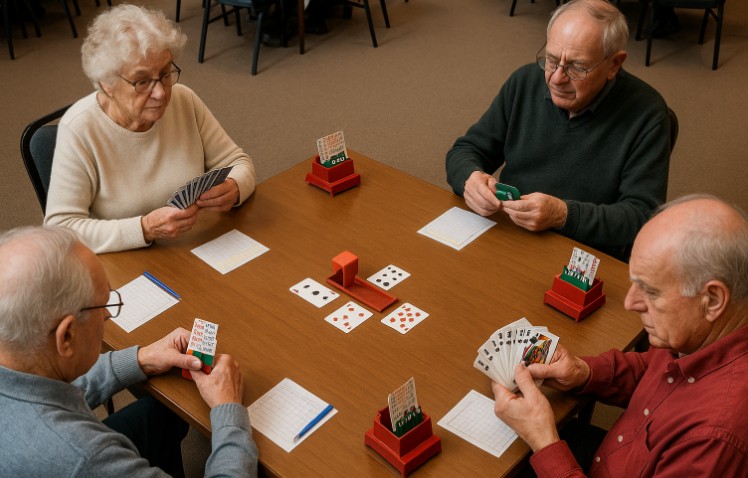The bridge card game is one of the most intellectually stimulating and strategically demanding card games in the world. Combining skill, tactics, communication, and probability, it attracts both casual players and competitive enthusiasts.
Played in clubs, tournaments, and online platforms across the globe, bridge requires a balance between understanding its basic rules and mastering advanced techniques that give players a competitive edge.
This guide explains not only how to play bridge but also how to apply advanced strategies that can significantly improve gameplay.
What Is Bridge Game?

Bridge is a partnership-based trick-taking card game played by four people using a standard 52-card French deck. It is widely regarded as one of the most challenging and intellectually rewarding card games due to its unique combination of tactics, communication, probability, and memory.
The game is structured around strategic decision-making, where partners work together to outscore their opponents over a series of deals.
The game’s origins can be traced back to 19th-century whist variants, eventually evolving into contract bridge in the 1920s, thanks to significant scoring and rule changes introduced by Harold Stirling Vanderbilt.
Today, it is played socially in homes, competitively in clubs, and at the highest level in international tournaments governed by the World Bridge Federation (WBF).
Key characteristics of bridge include:
- Players: Four players in two competing partnerships.
- Objective: To win the number of tricks bid in the auction phase.
- Skills Required: Strategic thinking, probability calculation, communication within the rules, and memory retention.
- Formats: Social play in rubber bridge or competitive play in duplicate bridge.
The appeal of bridge lies not only in mastering the rules but also in the endless variety of deals and the depth of partnership strategy, making it a lifelong pursuit for many players.
What Are the Basic Rules of the Bridge Card Game?
Bridge is a four-player partnership trick-taking card game played with a standard 52-card French deck. Partners sit opposite each other, and the game progresses clockwise. The card ranking is Ace (highest), King, Queen, Jack, 10 through 2 (lowest).
The game is structured into deals, and each deal has four phases:
- Dealing: Every player receives 13 cards.
- Bidding: An auction to decide the contract and trump suit (or no trump).
- Play: The declarer attempts to meet the contract, while defenders aim to defeat it.
- Scoring: Points are awarded for making or defeating the contract.
Two common formats exist:
- Rubber Bridge: Social play where a rubber is won by winning two games of at least 100 contract points.
- Duplicate Bridge: Competitive format where the same deals are played at multiple tables to compare results.
The objective in each deal is for the declaring side to win at least the number of tricks contracted for, with each contract promising tricks over the base of six. For example, a bid of 3♠ means nine tricks (six plus three) with spades as trump.
How to Play Bridge?

Bridge is played over a series of deals, each consisting of four main phases: dealing, bidding, play, and scoring. The game is always played with four players in two partnerships, with partners sitting opposite each other at the table.
1. Dealing the Cards
A standard 52-card deck is shuffled and dealt clockwise, one card at a time, until each player has 13 cards. In duplicate bridge, pre-dealt hands are often used for fairness in scoring.
2. Bidding (The Auction)
The bidding phase determines the contract the number of tricks a partnership commits to winning and the trump suit (or no trump). Players take turns making one of the following calls:
- Bid: Declaring a level (number of tricks over six) and a denomination (trump suit or no trump).
- Pass: Choosing not to bid.
- Double: Challenging the opponents’ contract for higher penalties if they fail.
- Redouble: Increasing the stakes further after being doubled.
The bidding continues clockwise until three consecutive passes end the auction. The final bid becomes the contract, and the player from that partnership who first named the contract’s denomination becomes the declarer.
3. Playing the Hand
- The player to the declarer’s left makes the opening lead.
- The declarer’s partner becomes the dummy and places their cards face-up on the table.
- The declarer plays both their own hand and the dummy’s cards.
- Players must follow suit if possible; if they cannot, they may play any card, including trumps.
- The highest card in the suit led wins the trick unless trumped, in which case the highest trump card wins.
4. Scoring the Deal
Points are awarded based on the number of tricks won compared to the contract. Trick values depend on the trump suit or no trump, with bonuses for making game contracts, slams, and for overtricks.
Penalties apply for failing to meet the contract, with values influenced by vulnerability and whether the contract was doubled or redoubled.
A successful bridge game requires not only following the rules but also making informed strategic decisions during bidding, play, and defence. Partnerships that communicate effectively within the rules often hold a significant advantage.
How Is Bridge Scoring Calculated?
Scoring in bridge rewards the declaring side if the contract is made and penalises them if it is not. Trick values depend on the trump suit or if there is no trump.
| Contract Type | Clubs/Diamonds | Hearts/Spades | No-Trump |
| First odd trick (above 6) | 20 points | 30 points | 40 points |
| Subsequent odd tricks | 20 points | 30 points | 30 points |
Additional scoring features include:
- Game bonuses: 300 points if not vulnerable, 500 points if vulnerable.
- Part-score bonuses: 50 points for contracts below game level.
- Slam bonuses: 500/750 points for small slams and 1000/1500 points for grand slams, depending on vulnerability.
- Overtricks: Scored at trick value or higher if doubled/redoubled.
- Undertricks: Penalty points to the defenders, increasing with vulnerability and doubling.
Vulnerability is a key factor in scoring, particularly in competitive play, as it influences both the risk and reward of bidding higher contracts.
How Does the Bidding System Work in Bridge?

Bidding is an auction where players decide the contract and communicate hand strength within strict rules. The dealer starts the auction, and bidding continues clockwise until three consecutive passes end the round.
Possible calls during bidding include:
- Pass: Declines to bid but allows later participation.
- Bid: Declares a contract level and denomination (trump suit or no trump) that exceeds the previous bid.
- Double: Challenges an opponent’s contract to increase penalties if they fail, and rewards if they succeed.
- Redouble: Increases stakes further after being doubled.
Opening bids typically require 12+ High Card Points (HCP). Bidding systems help partnerships interpret calls accurately. Common systems in the UK include Acol (with a weak 1NT opening of 12–14 HCP) and natural bidding styles.
Some widely used conventions are:
- Stayman: Asks partner if they hold a four-card major after a 1NT opening.
- Blackwood: Asks for the number of aces or key cards to explore slam potential.
- Jacoby Transfers: Allows the weaker hand to become declarer, concealing strength.
How Do You Evaluate Your Hand Strength in Bridge?
Hand evaluation is critical for making optimal bids. The basic High Card Point system assigns:
- Ace = 4 points
- King = 3 points
- Queen = 2 points
- Jack = 1 point
Distribution points are also added for short suits:
- Void = 3 points
- Singleton = 2 points
- Doubleton = 1 point
For example, a hand with A♠, K♠, Q♠, J♠, 10♠, plus smaller cards in other suits, scores highly in HCP but also gains extra value if spades are trump due to length.
Advanced players also use evaluation tools like the Losing Trick Count and Law of Total Tricks to refine bidding decisions, especially when considering pre-emptive bids or sacrifices.
What Are the Best Declarer Play Strategies in Bridge?
The declarer’s role is to fulfil the contract using both their hand and the dummy’s cards. Strategic planning before playing the first card is essential.
Core techniques include:
- Finesse: Attempting to trap a higher opposing card by leading towards your own honour.
- Establishing long suits: Forcing opponents to play out their high cards so smaller cards in a long suit can win.
- Crossruffing: Alternating trumps between hands to gain extra tricks when both hands are short in opposite suits.
- Hold-up play: Delaying the winning of a trick to disrupt defender communication.
An example of finesse in action: If declarer holds A-Q in dummy and small cards in hand, and an opponent is suspected of holding the king, leading towards the queen can win if the king is in the right position.
How Do You Defend Effectively in Bridge?

Defence is often harder than declarer play, as defenders can only see their own cards. Effective defence relies on partnership trust and clear signalling.
Defensive strategies include:
- Opening leads: Commonly the fourth-highest card from the longest suit, or top of touching honours (K from K-Q).
- Signalling methods: Encouraging or discouraging a suit through the choice of high or low cards.
- Count signals: Indicating the number of cards held in a suit to help partner plan the defence.
For instance, if defending a no-trump contract and leading fourth-highest from a long suit, partner may use a high card to encourage continuation if they have strength in the suit.
What Advanced Tactics Can Improve Your Bridge Game?
At higher levels, bridge strategy involves complex plays designed to manipulate opponents.
Notable advanced tactics include:
- Squeeze play: Forcing an opponent to discard a card they need to guard a suit.
- Endplay: Giving an opponent the lead at a point where any return benefits declarer.
- Trump management: Conserving trumps for later control, or forcing opponents to waste trumps early.
- Counting the hand: Tracking played cards to determine the exact distribution of unseen cards.
For example, in an endplay situation, declarer may deliberately lose a trick to force an opponent into leading a suit beneficial to the declarer’s position.
How Can Bridge Etiquette and Communication Enhance Gameplay?
Proper etiquette ensures fairness and smooth play. Bridge has strict rules prohibiting unauthorised communication, including gestures, facial expressions, or tone of voice that might convey information.
Good practice includes:
- Maintaining consistent tempo when bidding or playing cards.
- Using only agreed-upon conventions with your partner.
- Avoiding criticism of partner during play, saving discussion for post-game analysis.
In tournament settings, communication is further controlled with bidding boxes and, in higher-level competitions, screens between partners to eliminate visual cues.
Common Mistakes Beginners Make in Bridge

While beginners often grasp basic rules quickly, they frequently:
- Overbid without sufficient point strength.
- Ignore partner’s bids, disrupting the auction.
- Fail to plan their play before making the first move.
- Lead into declarer’s strong suit unnecessarily.
Tips for Competitive Bridge Tournaments
Success in competitive bridge requires preparation and mental discipline.
Players should:
- Practise regularly with a consistent partner to develop mutual understanding.
- Study scoring tables to assess risk versus reward, particularly regarding vulnerability.
- Review past deals to identify errors and missed opportunities.
- Remain attentive throughout the session, as even a single hand can influence final standings.
Conclusion
Learning how to play bridge card game effectively requires mastering the fundamentals of bidding, play, and defence.
However, applying advanced strategies like squeeze plays, precise signalling, and accurate hand evaluation can elevate a player’s success in both casual and competitive environments. With consistent practice, strong communication with a partner, and respect for bridge etiquette, players can transition from beginners to formidable competitors in this timeless game.
FAQs
What is the difference between rubber bridge and duplicate bridge?
Rubber bridge is played socially until one partnership wins two games, while duplicate bridge is tournament play where identical deals are compared across tables for scoring fairness.
Can you play bridge online for free?
Yes, several platforms like Bridge Base Online and Funbridge offer free play options with AI or real opponents.
How many points are needed to open in bridge?
Typically, 12 or more High Card Points are needed for an opening bid in most bidding systems.
What is the Stayman convention in bridge?
Stayman is a bidding convention used after a 1NT opening to ask partner if they hold a four-card major suit.
How long does a bridge game usually take?
A casual rubber bridge session can last 1–2 hours, while duplicate sessions often run for 3–4 hours depending on the number of boards.
Is bridge harder to learn than other card games?
Yes, bridge has a steeper learning curve due to its bidding conventions and strategic depth, but it is highly rewarding once mastered.
What is the role of the dummy in bridge?
The dummy is the declarer’s partner, who lays their cards face up after the opening lead. The declarer plays both their own and the dummy’s cards.







